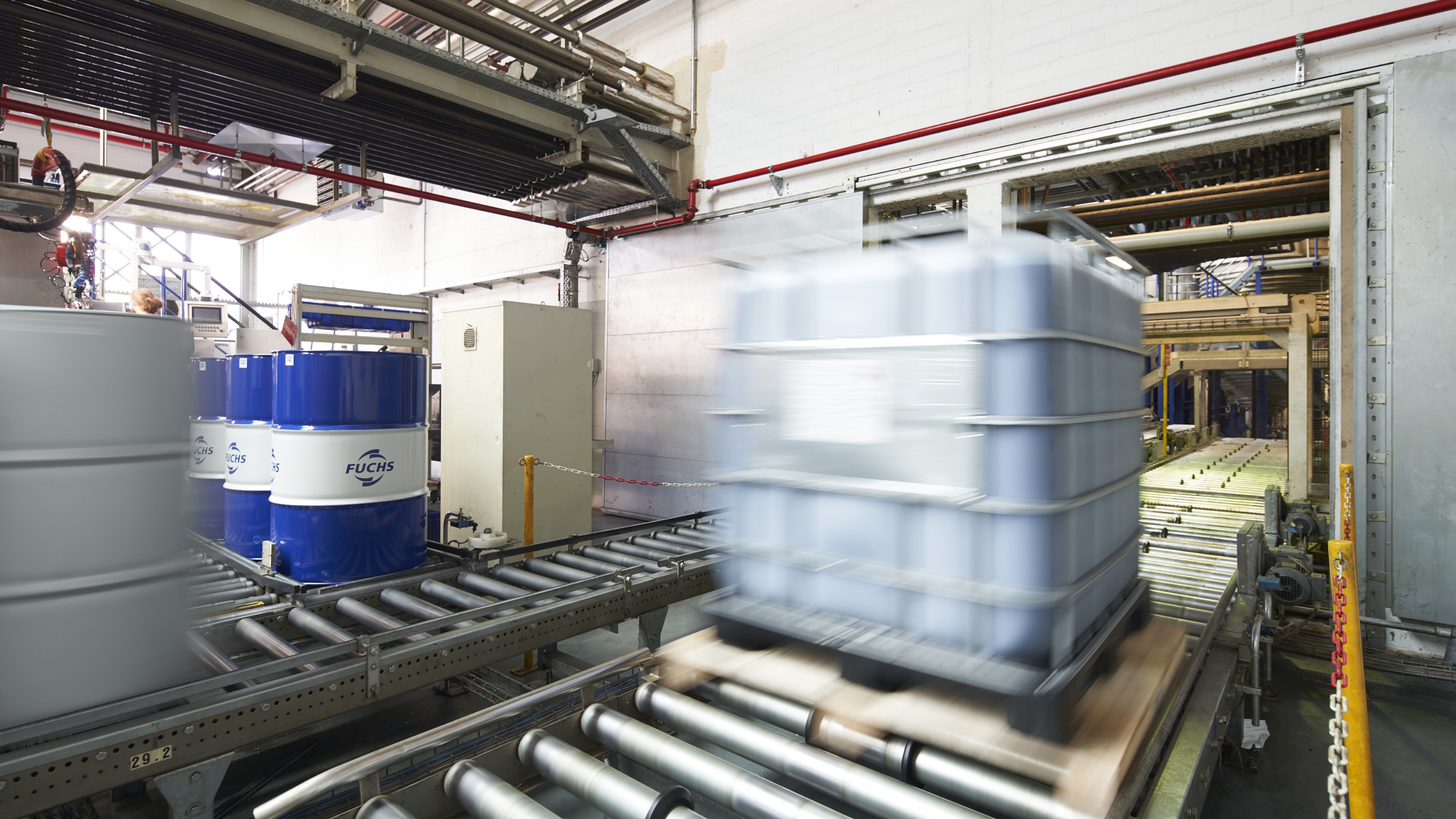Tests performed under real-world operating conditions are a key component of the lubricant development process. The specialist FUCHS PETROLUB focuses on modern testing procedures and their development. Impressions from the HQ in Mannheim and the newly acquired DEUTSCHE PENTOSIN-WERKE GMBH in Wedel – two of the largest test fields in the German lubricants industry.
“Testing in progress. Please do not enter the machine room!” The heavy door is closed. When looking through the viewing window, your attention is immediately drawn to a Plexiglas box of roughly the size of a wardrobe. It contains the drive shafts from a vehicle, which are as thick as broomsticks and are starting to pick up speed. The four shafts, which are attached to a total of eight joints, are turning faster and faster. Air is blown through wide hoses to simulate the air stream. This is one of two drive shaft test rigs at FUCHS HQ in Mannheim that are used to test the endurance of grease in joints of this type.
A few doors further, grease endurance life measurements are being performed at high temperature and high speed on rolling bearings, such as those used in car wheel bearings, electric motors, or machine tools. Tests like this can easily take 1,000 to 2,000 hours, i.e. six to twelve weeks. Creating real-world operating conditions is a key component of lubricant testing. As the world’s largest independent lubricant manufacturer, the Mannheim-based family company intentionally focuses on test procedures of this kind, as they represent a key quality feature.
Up to 35 test rigs of this kind can be operated at the same time in Mannheim, spread over approximately 1,600 square meters in a three-story building. “Our testing facilities are certainly among the largest used by the lubricants industry in Germany,” explains Dr. Christian Seyfert, who has managed the FUCHS test field since 2004. It is home to mechanical test rigs for lubricating oils, greases and fluids used in the metalworking industry. “With the exception of running engines, we actually test everything,” comments the Doctor of Physics.
For example, tests are performed on the foaming characteristics of passenger vehicle axle drives at various operating temperatures and speeds. The effectiveness of lubricants when adjusting seat backrests in passenger cars is also tested under variable loads. A new test rig simulates various aspects of sheet metal forming, such as those used in car body manufacturing or rolling mills. During testing, the respective lubricant is always intentionally taken to its load limit – or beyond.
RESULTS OBTAINED MORE QUICKLY
Seyfert explains the start of the testing process: “The customer approaches us with a special requirement in his specific application. We then take a close look to determine what exactly needs to be simulated in our tests.” In the case of damage to bearings or transmissions due to wear, this might include testing the lubricant-specific influence on the wear behavior of the respective product.
Seyfert describes the test procedure at the rolling bearing test rig for axle oils with regard to fatigue wear. “For this measurement, we intentionally increase the load on the part being tested, for example by increasing the speed,” explains the 48-year-old. “Everything runs very fast, and we get results within a very short time that would otherwise take years or even decades.”
For example, if the specialists determine after a certain time that the first damage to the system is likely to occur after 30 million load cycles, they head over to their colleagues in the laboratory. “We then change the chemical composition of the lubricant so it can withstand greater loads. This allows the vehicle part to achieve a longer service life,” explains the head of the test field.
Continuous stress tests of this kind not only save customers test- ing costs, they also provide time benefits as to the competition thanks to their comparably short duration. “We target the specific requirement being faced by our customers. This is certainly one of our major strengths,” stresses Seyfert, who has been with FUCHS since 1999. Naturally, internal product development also benefits from the fast test results.
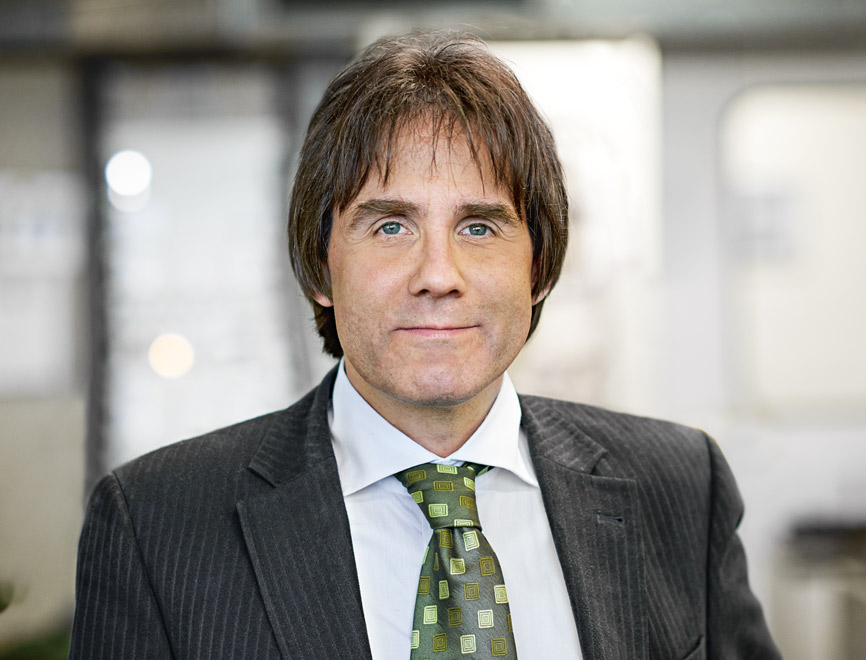
» With our testing procedures, we address the specific requirements of our customers. This is certainly one of our major strengths.«
In the future, FUCHS will have space for 50 test rigs at its Mannheim HQ. It currently houses 35 – several of which were developed and constructed by the in-house specialists themselves.
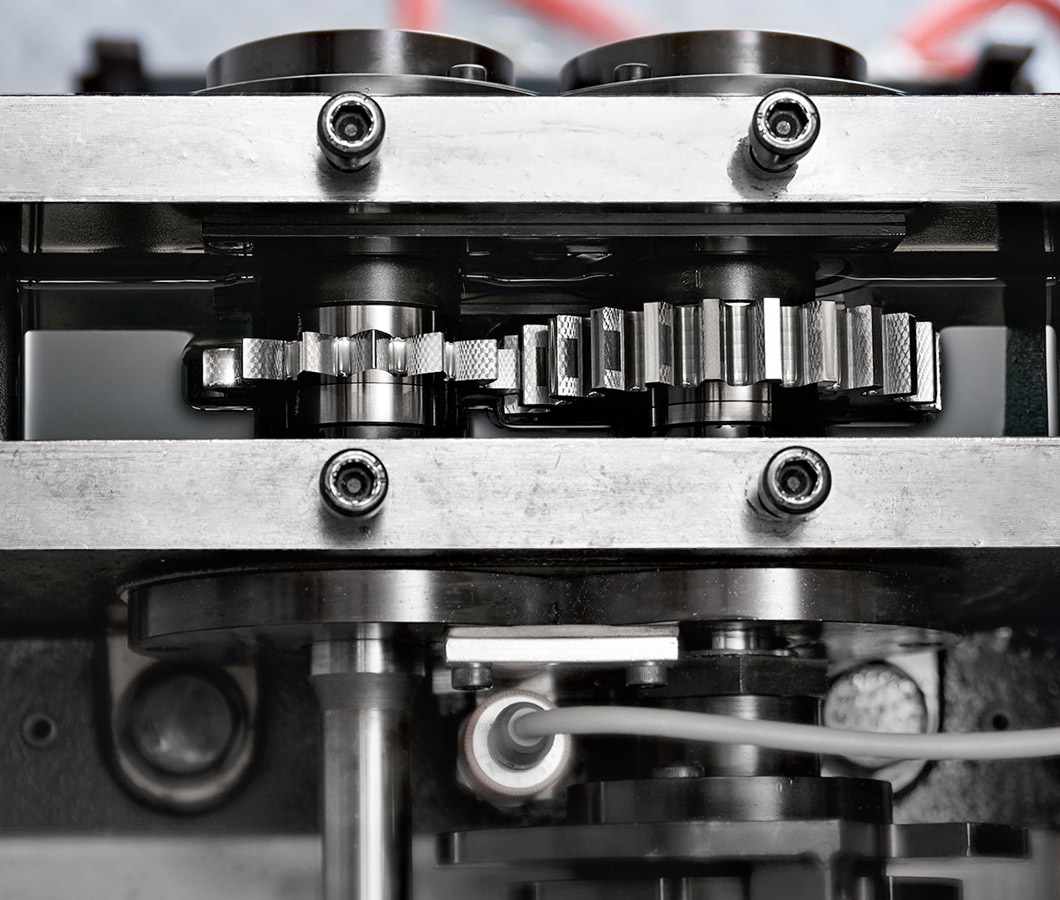
“FZG test” of the load capacity of gear oil. When does damage occur to the tooth flanks of the gears being tested?
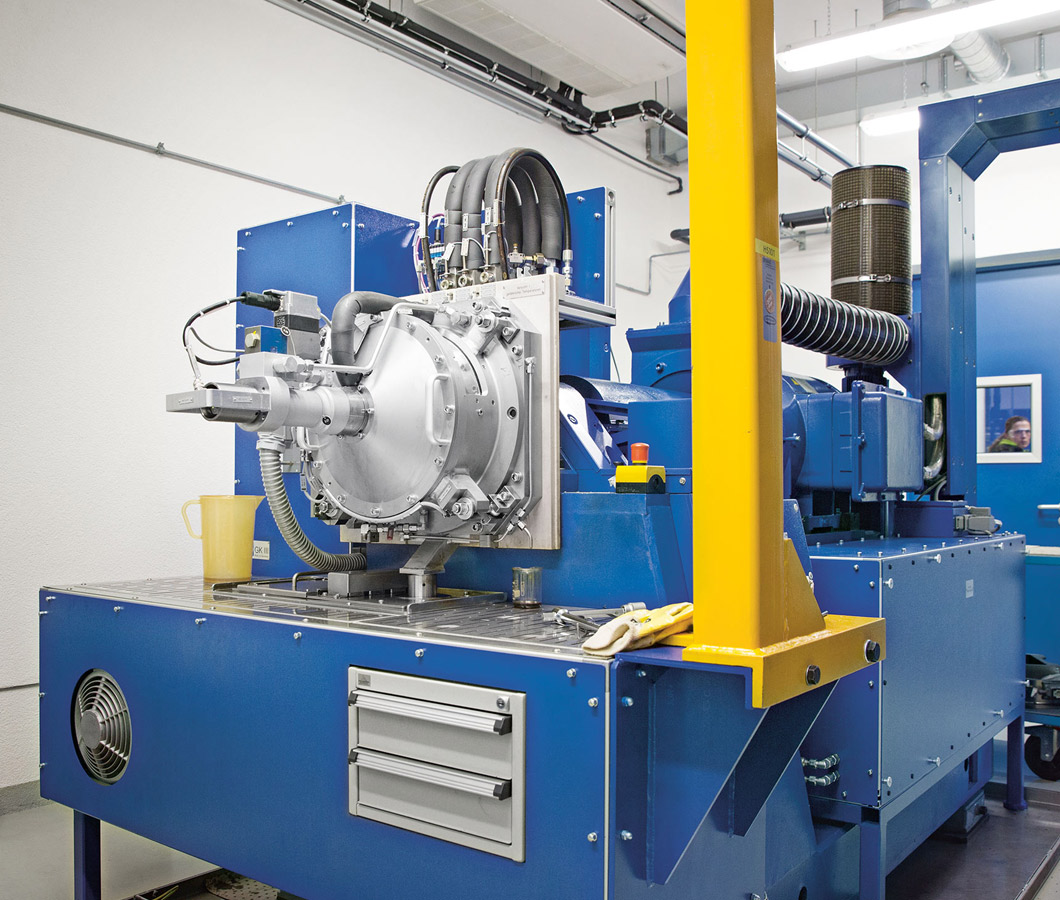
“GK3” test rig in Wedel: Gear oil must demonstrate its performance in conjunction with original clutch discs in the round testing head.
A TEAM OF EXPERTS
To ensure that everything works smoothly, the lubricant manufacturer employs a team of experts from various disciplines at its Mannheim testing facilities to secure a broad range of skills.
Among these experts are specialists capable of designing, constructing and adapting test rigs when the specific requirement being faced by a customer demands this – for example hydraulic test rigs with vane cell pumps as used in vehicle power steering systems. The FUCHS specialists then address all mechanical aspects of the test rig, the measuring technology employed, all safety considerations, as well as complete documentation. A project of this type can take two months to complete or sometimes even an entire year in the case of complex test rigs. With this special test rig development expertise and its complex technological know-how, the Mannheim testing facilities play a vital role within the Group, as underlined by Seyfert. All highly specialized testing procedures come together at this central location. “We therefore also see ourselves as a service provider for the entire FUCHS Group.”
A NEW MEMBER OF THE FUCHS FAMILY
A new addition to the FUCHS family also has crucial testing capacities that are key for exceptional innovations: DEUTSCHE PENTOSIN-WERKE GMBH. Let us now move around 360 miles north to the HQ of PENTOSIN in Wedel. The single-story test field build- ing is surrounded by massive mixing tanks. “PENTOSIN’s special strength lies in the OEM business with transmission fluids, particularly for dual-clutch transmissions,” comments Edgar Steigerwald, Doctor of Chemistry and Head of Research & Development at PENTOSIN. The long-standing company from Wedel enjoys a leading position in the DSG segment (direct-shift gearboxes) in terms of both development and production of suitable fluids. The testing facilities also play a key part for these two areas.
It is managed by vehicle engineer Martin Knaffel. He explains the special challenges resulting from the design of dual-clutch transmissions: “On the one hand you have gears and synchronization just like a manual transmission. This obviously requires wear resistance. On the other hand, however the same fluid lubricates and cools the clutches, so you clearly need special friction characteristics.” These are contradictory requirements, so the art lies in striking the optimum balance. “Not just for a brief moment, but for more than 40,000 miles.”
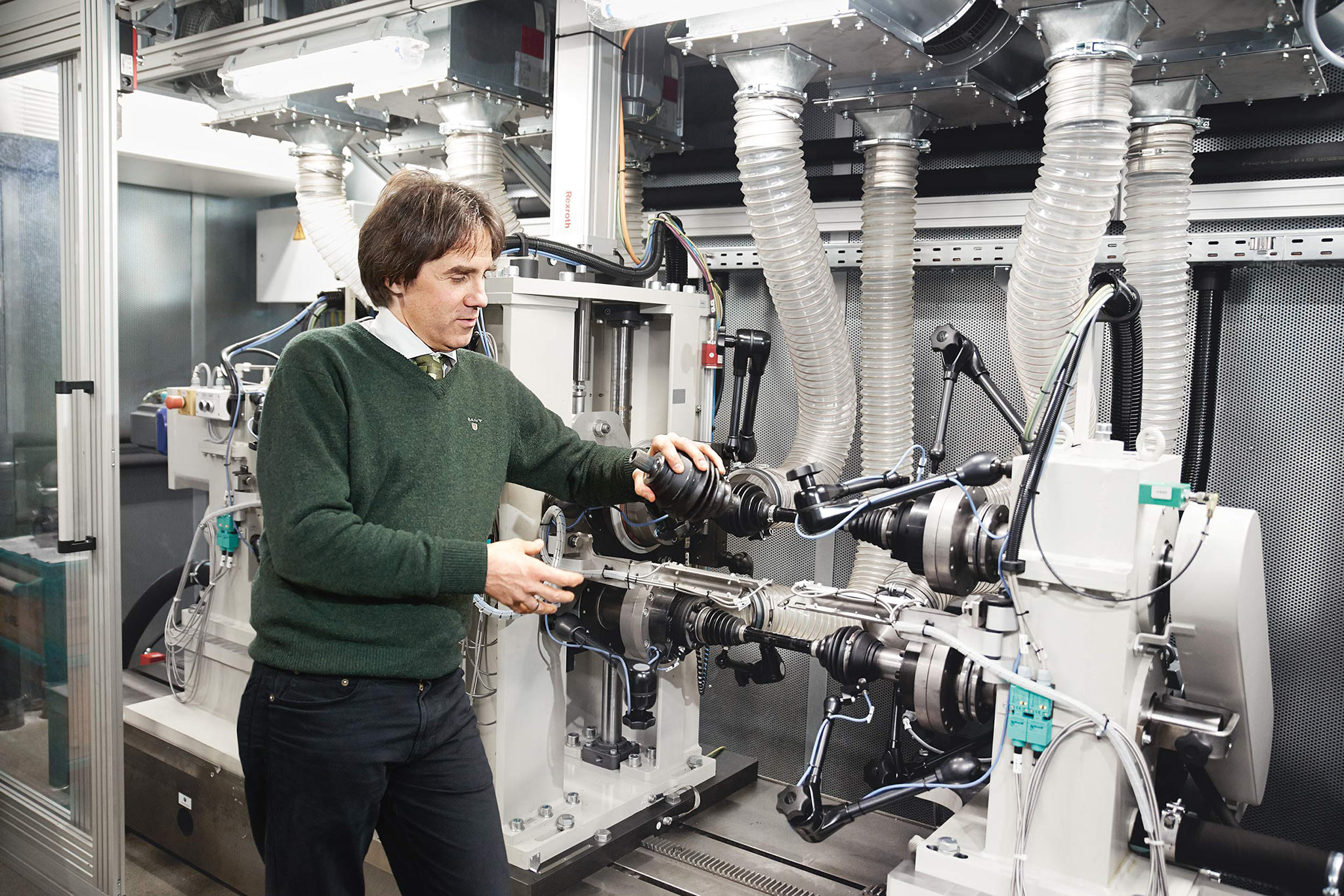
Head of the FUCHS test field, Dr. Christian Seyfert, explains the drive shaft test rig.
THOUSANDS OF CLUTCHING AND DECLUTCHING OPERATIONS
Tests are needed to demonstrate whether this balance is successful– focusing in particular on one of the three so-called GK test rigs that sit at the heart of the Wedel testing facilities. Two of these rigs can be seen directly through the window of the test field team’s office. They are man-sized dark blue units, and the accompanying switching and measuring technology in addition takes up the space of a large wardrobe. In contrast, the steel-gray testing heads on the front look rather inconspicuous. Packages of original clutch discs from transmission manufacturers are inserted and lubricated with the fluid being tested. In addition to this, the test rig simulates certain design-specific operating parameters. After all, the manufacturers each have their own tricks up their sleeves in terms of the materials used and many other details regarding the design of the gearbox. Testing on the rigs must therefore be very carefully planned and programmed to deliver meaningful results. The key then is to wait. A typical test can take hours or even days, during which many thousands of clutch engaging and disengaging operations are performed fully automatically under variable load and temperature conditions, while digitally capturing a wide range of measured variables.
“There are around 40 test rigs of this kind in the world – so we are very well equipped with our three units,” reports Knaffel. Yet despite this, the capacities are fully utilized. Besides new fluid devel- opments, design changes made by the hardware manufacturers also have to be examined in new test runs. The head of the test field therefore hopes that a fourth GK test rig will soon be acquired – despite the rather hefty price tag of €750,000 excluding building infrastructure costs.
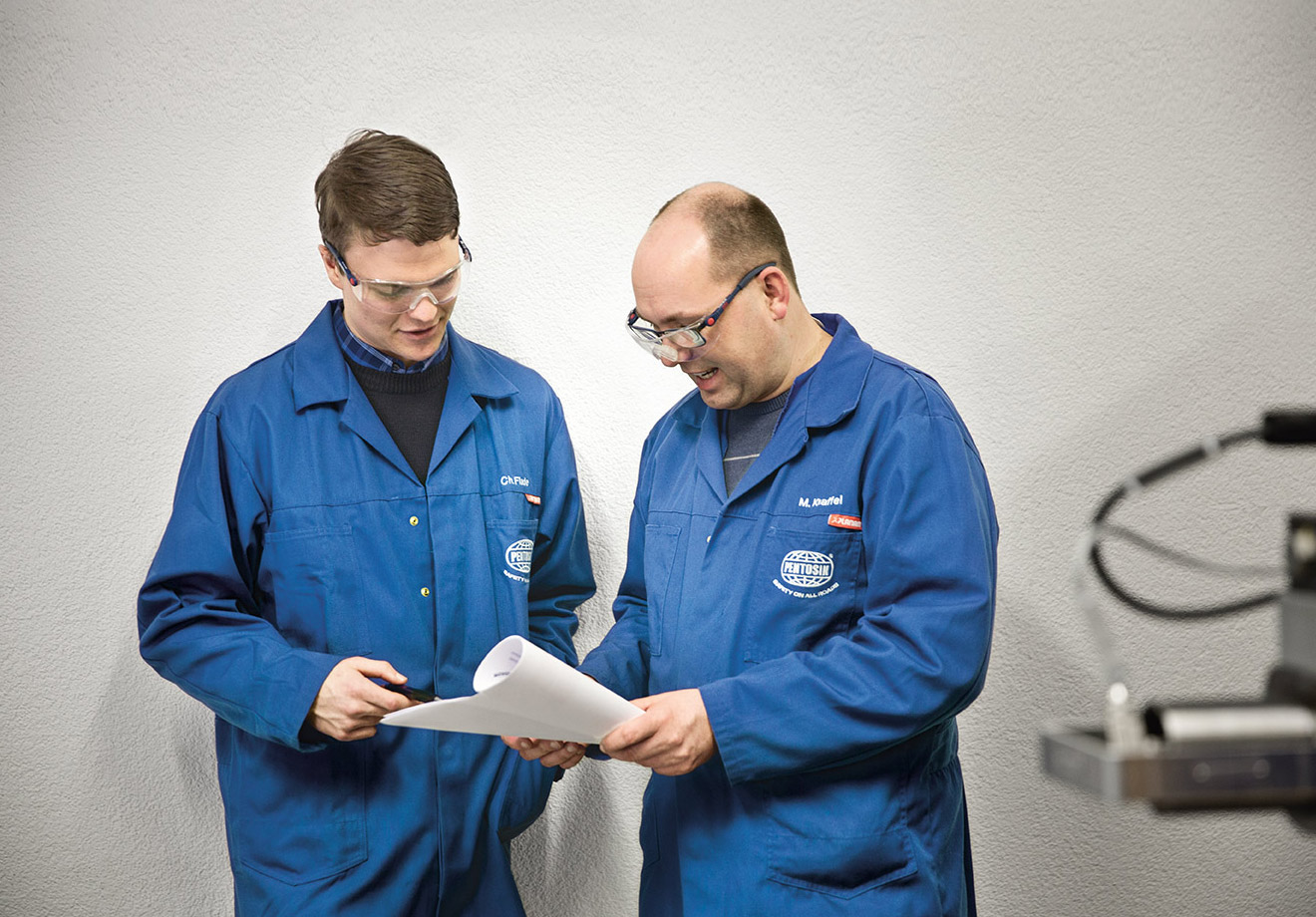
Head of the PENTOSIN test field, Martin Knaffel (on the right), discusses test results with a colleague.
3E MACHINE TEST RIG
Staff at the Mannheim test field are also looking forward to using further specialized technology when the new test field building at the Plant 1 site is ready for operation (please refer to “Greater capacities”). It will house a large test rig for vehicle transmission testing with electrical simulation of engine and wheels – a so-called 3E machine test rig. “While in the past we have only examined individual components in our transmission fluid tests, in the future we will be able to focus on complete transmissions and the inter- action between the individual parts,” explains Dr. Christian Seyfert. This testing system, which will also be used for testing truck components in the mid-term, measures nine by eight meters and will be housed in the new building. Once installed, it will be the largest stand-alone test rig in the history of FUCHS.
GREATER CAPACITIES
MANNHEIM: NEW TEST FIELD BUILDING
A new test field building, offering around 1,200 square meters of additional floor space, has been built at the Plant 1 site at the FUCHS HQ in Mannheim. Staff are scheduled to move into the new building, which will offer space for up to 15 further test rigs in the mid-to-long-term, in the second quarter of 2016. The total costs, including installation of the new high-performance testing systems, are in excess of €10 million. Among other things the new building will be used for comprehensive tests of automotive transmission fluids as well as shock absorber oils.

Dr. Lutz Lindemann
Chief Technical Officer at FUCHS PETROLUB SE
3 questions for
Dr. Lutz Lindemann
Chief Technical Officer at FUCHS PETROLUB SE
Dr. Lindemann, why is FUCHS focusing on real-world testing procedures in its lubricant development operations?
We are positioned in the market as a company that claims technological leadership in many areas. This is why we need such extensive testing of our products in the fields of tribology and lubricant technology. We are keen to provide our customers with lubricants that they do not first need to test in real operating conditions themselves. Instead, we offer fully tested products with ultimate operational reliability at the end of the development cycle.
How do you set standards in the sector?
We do not run any standard tests in our testing facilities, but rather focus on tests with very specific measuring procedures. We are highly specialized, and the test field activities represent an integral part of our research and development work. The harmonious interaction of these two areas is what makes us so strong. Our excellent position in the OEM business, for example, is only possible thanks to these comprehensive individual tests. Extending our test field capacities with the new building in Mannheim was therefore the next logical step.
So where will the research and development challenges lie in the future?
New materials such as special plastics or surface coatings are entering the market. We therefore need to engage in even more intensive basic research, also with regard to the availability of raw materials. In the future the focus will be more on biological and biologically modified raw materials that offer high functionality. With Lignin, which is a kind of waste molecule from paper manufacturing, we have already developed and launched an alternative product to one of our conventional solid lubricants. In the future, this area of research will be an important part of our work.


